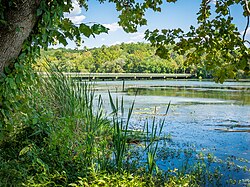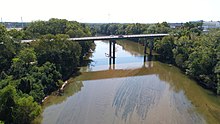Ocmulgee River
| Ocmulgee River | |
|---|---|
 Ocmulgee River in Monroe County Recreational Park | |
 Map of the Ocmulgee River watershed highlighted; river is dark blue | |
| Location | |
| Country | United States |
| State | Georgia |
| Physical characteristics | |
| Source | Confluence ofSouth,Yellow,andAlcovyrivers |
| • location | Lloyd Shoals Dam |
| • coordinates | 33°19′15″N83°50′39″W/ 33.32083°N 83.84417°W |
| Mouth | Altamaha River |
• location | Hazlehurst |
| Length | 255 mi (410 km) |
| Basin features | |
| Tributaries | |
| • left | South River |
| • right | Yellow River,Alcovy River |
TheOcmulgee River(/ɒkˈmʌlɡiː/) is a westerntributaryof theAltamaha River,approximately 255 mi (410 km) long, in theU.S. stateofGeorgia.It is the westernmost major tributary of the Altamaha.[1]It was formerly known by itsHitchitiname of Ocheese Creek, from which theCreek(Muscogee) people derived their name.
The Ocmulgee River and its tributaries providedrainagefor some 6,180 square miles in parts of33 Georgia counties,a large section of thePiedmontandcoastal plainof central Georgia.[1]
The Ocmulgee Riverbasinhas three river subbasins designated by theU.S. Geological Survey:the Upper Ocmulgee River subbasin (hydrologic unit code03070103); the Lower Ocmulgee River Subbasin (03070104); and the Little Ocmulgee River Subbasin (03070105).[2]
The name of the river may have come from aHitchitiwordsoki( "water" ) plusmolki( "bubbling" or "boiling" ),[3]possibly meaning "where the water boils up."[1]

Description
[edit]The riverrisesat a point in north central Georgia southeast ofAtlanta,at the confluence of theYellow,South,andAlcovyrivers.[1]Since the construction of the Lloyd Shoals Dam in the early 20th century, these rivers join as arms of theJackson Lakereservoir.[1]The river's source is formed at an elevation of around 530 feet abovesea level.[1]
The Ocmulgee River flows from the dam southeast pastMacon,which was founded on theFall Line.It joins theOconeefrom the northwest (241 miles downstream from Jackson Lake) to form theAltamahanearLumber City.[1]The Ocmulgee River Water Trail begins from Macon'sAmerson River Parkto the confluence near Lumber city and Hazelhurst, encompassing approximately 200 miles.[4]
Human use
[edit]Fourpower plantsin the Ocmulgee basin that use the river's water, including thecoal-firedPlant SchererinJuliette,operated by theGeorgia Power Company.[5]Plant Scherer is the seventh-largest power plant in the United States by capacity (based on 2016 data)[update],and the largest to be fueled exclusively by coal.[6]
Fish fauna
[edit]A diverse array of fish—105 species in twenty-onefamilies—inhabit the Ocmulgee River basin.[2]The family with the largest representation in the river basin isCyprinidae(carp and true minnows), with 27 species.[2]It is followed byCentrarchidae(sunfish), which has 22 species.[2]The Ocmulgee basin contains ten species in the familyIctaluridae(catfish) and eight species of in the familyCatostomidae(suckers).[2]The river basin is also inhabited by one State of Georgia-designatedendangeredfish species, the Altamaha shiner (Cyprinella xaenura) and two designated rare species, thegoldstripe darter(Etheostoma parvipinne) andredeye chub(Notropis harperi).[2]
The Ocmulgee River is popular withanglersfor its excellent fishing, particularly forredbreast sunfish,bluegill,redear sunfish,largemouth bass,black crappie,channel catfish,andflathead catfish.[2]The world record for largest recorded catch of alargemouth basswas achieved in 1932 in Montgomery Lake, anoxbow lakeoff the Ocmulgee River inTelfair County.[2][7]The record-setting fish, caught by farmer George Washington Perry, weighed 22 pounds, 4 ounces.[7][8]TheInternational Game Fish Associationofficially declared the world record for largemouth bass tied in 2010, following Manabu Kurita's catch (in July 2009) of a 22 pound, 4 ounce largemouth taken fromLake BiwainJapan.[9]
There are some fifteeninvasive speciesof fish which inhabit the river basin.[2]According to aGeorgia Department of Natural Resourcesreport, "many of these species are well-established and are detrimental to native fish populations.[2]The fifteen invasives arethreadfin shad(Dorosoma petenense),goldfish(Carassius auratus),grass carp(Ctenopharyngodon idella),blacktail shiner(Cyprinella venusta);common carp(Cyprinus carpio);flathead catfish(Pylodictis olivaris);white bass(Morone chrysops);moronehybrids (Moronesp.);green sunfish(Lepomis cyanellus);longear sunfish(Lepomis megalotis);Lepomishybrids (Lepomissp.);shoal bass(Micropterus cataractae);spotted bass(Micropterus punctulatus);white crappie(Pomoxis annularis); andyellow perch(Perca flavescens).[2]
History
[edit]Archeological evidence shows thatNative Americansfirst inhabited the Ocmulgee basin about 10,000 to 15,000 years ago (seesettlement of the Americas).[1]Scraping tools andflint spearpointsfromnomadicPaleoindianshunters have been discovered in the Ocmulgee floodplain.[1]
In theArchaic period(c. 8000-1000 BCE) which followed, hunter-gatherers in Ocmulgee basin used fiber-temperedpottery andstone tools.[1]During theWoodland period(c. 1000 BCE-900 CE), there were various villages in the area, evidenced by earthen mounds and potterysherds.[1]
There is evidence that theMississippian culturereached the Ocmulgee basin by 900 CE; according to theNew Georgia Encyclopedia,"on the Macon plateau and in the nearby Ocmulgee bottomlands, stretches of farmsteads and gardens constructed around elaborate ceremonial mounds are the most prominent evidence of this early Mississippian influence."[1]These areas are now part of theOcmulgee National Monument,aNational Park Service-administered protected area established in 1936.[1]
Europeans first exploredthe Ocmulgee basin in 1540, during the expedition of the Spanish explorerHernando de Sotoand his party, who visited the late Mississippian chiefdom ofIchisi,now identified by archeologists as the floodplain south ofMacon.[1]The Ichisi served corncakes,wild onion,and roastedvenisonto De Soto and his party.[1]Over the next hundred years, however, the Native Americans in the area were devastated fromdisease and chaos following European contact.[1]
Between 1689 and 1692, a number of towns of theApalachicola Provincelocated on theChattahoochee Rivermoved to central Georgia, settling in the area of the Ocmulgee River, which the English at the time called Ochese Creek. In 1715, the English recorded ten towns among the "Ochese Creek Indians" (which the Spanish called "Uchese" ), with a population of 2,406. Early 18th century maps show a total of twelve towns in the vicinity of Ochese Creek, many with names corresponding to towns that had been on the Chattahoochee River. TheMuscogee-speaking towns ofCoweta,Kasihta,Tuskegee, and Koloni were located on the north side of the cluster. Several of theHitchiti-speaking towns were located to the southern part of the Ochese Creek cluster, including Ocmulgee, Hitchiti, and Osuchi. Two Muskogee-speaking towns from theTallapoosa Riverin Alabama, Atasi and Kealedji, joined the cluster of towns around Ochese Creek, as did the Hitchiti-speaking town ofChiahafrom western North Carolina. The Ochese Creek cluster also includedWestoandYuchitowns. Following the outbreak of theYamassee Warin 1715, the Ochese Creek towns moved west, mostly returning to the Chattahoochee River, where they evolved into theLower Towns of the Muscogee Confederacy(referred to by the English as the "Lower Creeks" ).[10]
Eli Whitney's invention of thecotton ginstimulated development of short-staple cotton plantations in the uplands, where it grew well. The gin mechanized processing of the cotton and made it profitable. Demand for land in the Southeast increased, as well as demand for slave labor in the Deep South. In 1806, the U.S. acquired the area between the Oconee and Ocmulgee rivers from the Creek Indians by theFirst Treaty of Washington.That same yearUnited States ArmyestablishedFort Benjamin Hawkinsoverlooking the Ocmulgee Fields. In 1819 the Creek held their last meeting at Ocmulgee Fields. they ceded this territory in 1821.

In the same year, the McCall brother established a barge-building operation at Macon. The firststeamboatarrived on the river in 1829. During the 19th century, the river provided the principal water navigation route for Macon, allowing the development of thecottonindustry in the surrounding region. In 1842 the river was connected byrailroadtoSavannah.The river froze from bank to bank in 1886. In 1994 devastating floods on the river after heavy rains caused widespread damage around Macon.[11]
Ocmulgee creeks
[edit]Major creeks that flow into the Ocmulgee River include:
- Tucsawhatchee Creek
- This tributary is largely known as "Big Creek" on most maps. While USGS does recognize Tucsawhatchee Creek, even their maps name it as "Big Creek."[12]
- Echeconnee Creek
- This tributary's name means "deer trap" in theMuscogee language,the language of theCreek.It refers to the steep incline of the creek where Creeks would trap deer, luring them into steep areas and then charging them.
- Alligator Creek
- Big Indian Creek
- Coley Creek
- Big Horse Creek
- Flat Creek
- Folsom Creek
- Horse Creek
- Jordan Creek
- Limestone Creek
- Little Ocmulgee River(Gum Swamp Creek)
- Little Shellstone Creek
- Little Sturgeon Creek
- Mossy Creek
- Otter Creek
- Richland Creek
- Sandy Run Creek
- Savage Creek
- Shellstone Creek
- South Shellstone Creek
- Sturgeon Creek
- Sugar Creek
- Ten Mile Creek
- Tobesofkee Creek
- Walnut Creek
See also
[edit]References
[edit]- ^abcdefghijklmnopOcmulgee River,New Georgia Encyclopedia(August 9, 2004).
- ^abcdefghijkOcmulgee River Basin Plan, Section 2: River Basin Characteristics,Georgia Department of Natural Resources, Environmental Protection Division.
- ^Bright, William(2004).Native American placenames of the United States.University of Oklahoma Press. p. 347.ISBN978-0-8061-3598-4.Retrieved16 September2011.
- ^"Ocmulgee River Water Trail | Georgia River Network".Retrieved2019-07-11.
- ^Ocmulgee River: Quick Facts about the River,Georgia River Network (accessed June 6, 2015).
- ^"Electricity in the United States - Energy Explained, Your Guide To Understanding Energy - Energy Information Administration".www.eia.gov.Retrieved2018-05-10.
- ^abRichard J. Lenz,Highroad Guide to the Georgia Coast and Okefenokee(Longstreet Press: 1999), p. 199.
- ^Monte Burke,Sowbelly: The Obsessive Quest for the World-Record Largemouth Bass(Penguin Group USA, 2006), p. xiii.
- ^Dale Bowman,World-record largemouth bass tie: Formal word,Sun-Times(January 8, 2010).
- ^Worth, John E. (2000)."The Lower Creeks: Origin and History"(PDF).In McEwan (ed.).Indians of the Greater Southeast: Historical Archaeology and Ethnohistory(Bonnie G. ed.). University of Florida Press. pp. 278–286.ISBN9-780-8130-2086-0.
- ^"1994 flood",Centers for Disease Control
- ^"Tucsawhatchee Creek Near Hawkinsville, GA".
- Snow, Dean (2010).Archaeology of Native North America.Upper Saddle River, NJ: Prentice Hall. pp. 208–209.ISBN978-0-13-615686-4.
Relevant readings
[edit]- Watson, Chris. 2022.The Wild and the Sacred: Evaluating and Protecting the Ocmulgee River Corridor,Vol. 1. Series edited by S. Heather Duncan. Macon, GA: Mercer University Press.
- Day, Dominic. 2022.A River of Time: Archaeological Treasures of the Ocmulgee Corridor,vol. 2. Series edited by S. Heather Duncan. Macon, GA: Mercer University Press.
- Bigman, Daniel Philip.From Settlement to Society: A History of the Early Mississippian Settlement at Ocmulgee,Volume 3. Series edited by S. Heather Duncan. Macon, GA: Mercer University Press.
